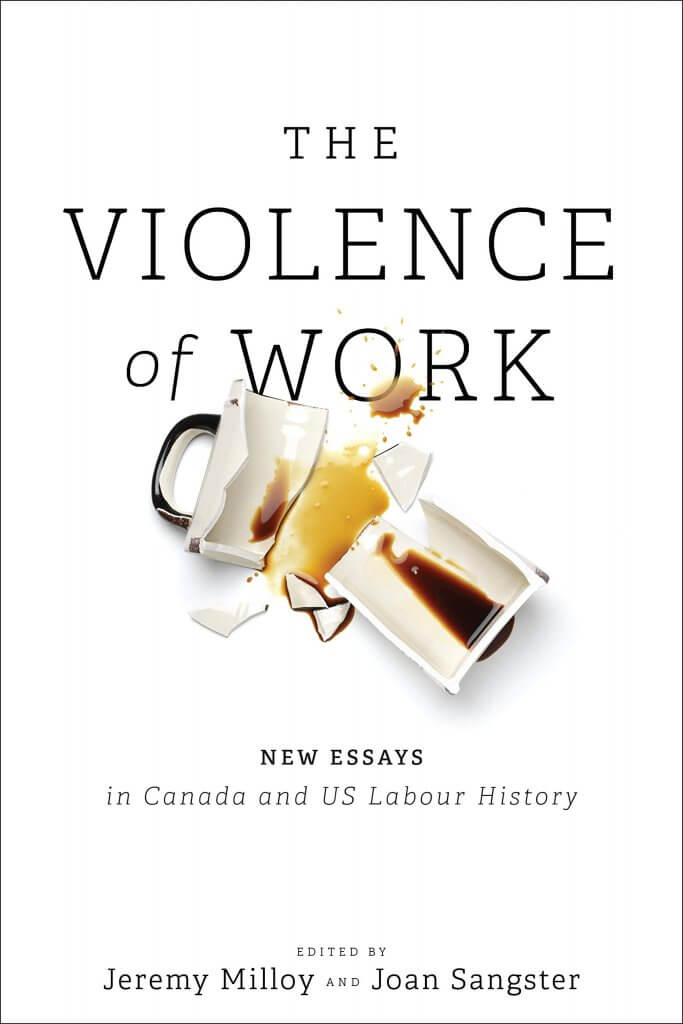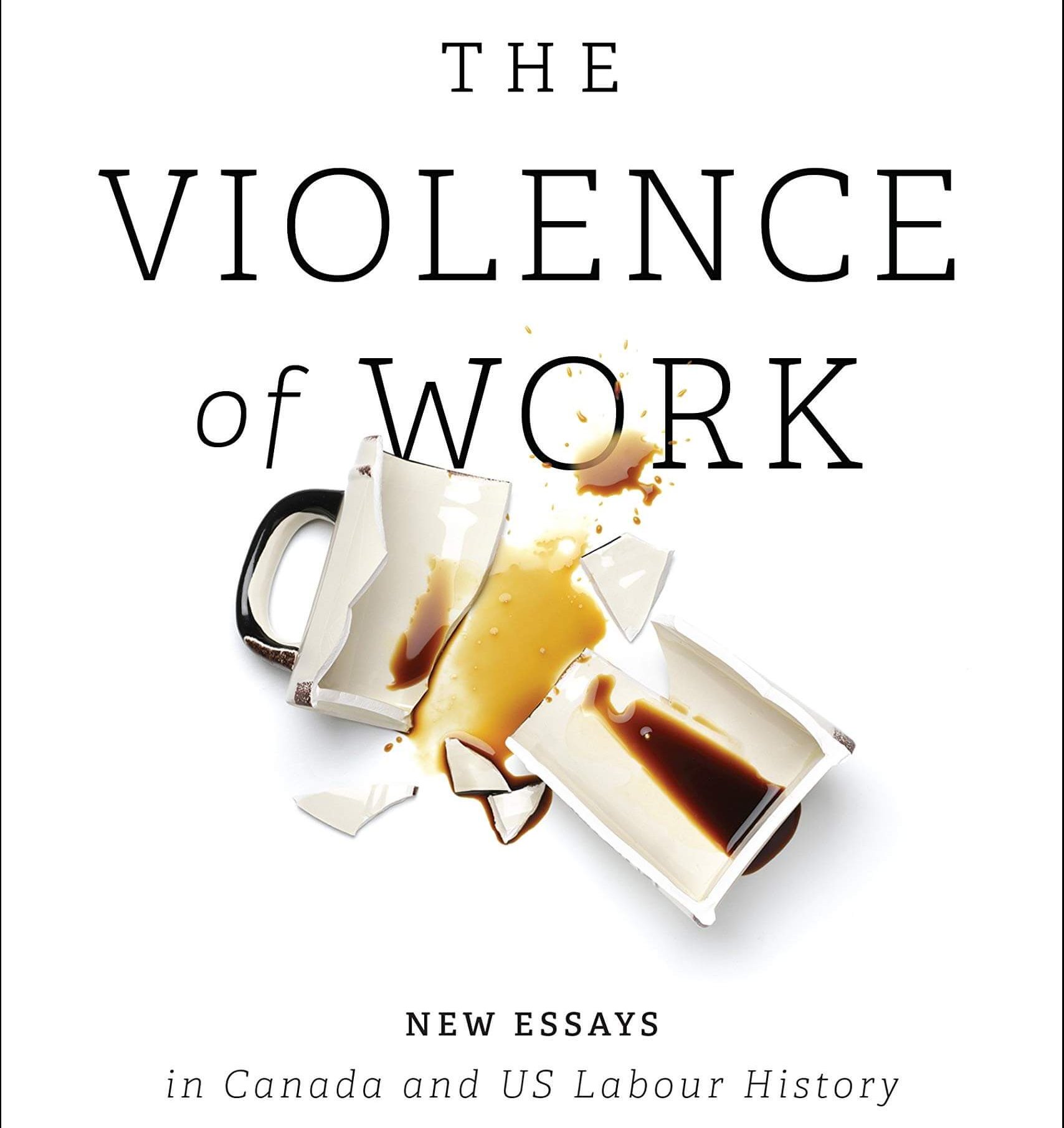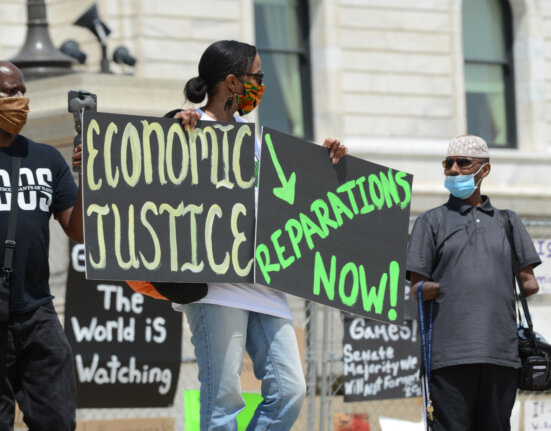According to a recent study by the AFL-CIO, on average 275 workers in the United States die each day due to job injuries and illnesses caused by working in unsafe spaces. In Canada, a 2020 report indicates 1,027 workers died of work-related causes in 2018, marking an increase of 76 from 2017. A new book, The Violence of Work: New Essays in Canadian and US Labour History (University of Toronto Press, 2021) takes on this topic and offers new perspectives on an old story – when your workplace is a dangerous space.
Edited by two Canadian labour historians, Jeremy Milloy and Joan Sangster, The Violence of Work focuses attention on the everyday violence of the workplace often “ignored” by scholars and seeks to “…zoom out to reveal the wider violences of work under capitalism…” (7). Further, by analyzing violence, the book’s contributors provide “…a promising way to understand and theorize more broadly about work under capitalism.” (5)
For this Labor Online forum, I posed a series of questions to co-editor Jeremy Milloy and two Canadian scholars and book contributors, Sarah Jessup and Mary Anne Poutanen, whose work overlaps with my area of research – sexual violence in the workplace. (And, full disclosure, I am also a contributor to the volume.)

Jeremy Milloy, who co-edited The Violence of Work with historian Joan Sangster, is the author of Blood, Sweat, and Fear: Violence at Work in the North American Auto Industry, 1960-1980 (2017) researches, writes, and teaches about work, violence, addiction, and capitalism in Canada and the United States. Mary Anne Poutanen teaches interdisciplinary studies at McGill University in the Programme d’études sur le Québec and at the McGill Institute for the Study of Canada and part-time in the Department of History at Concordia University where she is an affiliate professor. She is the author of the book Beyond Brutal Passions: Prostitution in Early Nineteenth-Century Montreal, for which she received the Prix Lionel-Groulx by L’Institut d’histoire de l’Amérique française in 2016. Her essay, “The Perils of Sex Work in Montreal: Seeking Security and Justice in the Face of Violence, 1810-1842,” explores life in Montreal brothels and the “real and potential violence” of everyday life and how female brothel owners, unable to rely on the criminal justice system, “… introduced a number of measures to make their workplaces and homes, both on the streets and in brothels, as safe as possible.” (17) Sarah Jessup, a PhD candidate in Canada Studies at Trent University, researches the relationship between policy, gender, and workplace bullying in Canada’s health care settings. In “The Murder of Lori Dupont: Violence, Harassment, and Occupational Health and Safety in Ontario,” Jessup “…traces how the murder of Lori Dupont…ultimately came to catalyse a shift in understandings of domestic violence…as a workplace safety issue in Ontario.” (133).
In the introduction, Milloy writes “… analyzing violence is a promising way to understand and theorize more broadly about work under capitalism.” (5) This is the foundation of the volume which traces violence at work from the early 1800s to the present day.
In an effort to further explore this argument, I asked Milloy, Pouttanen, and Jessup, “Does a system of capitalism mean that violence in the workplace is inevitable?”[1] For Milloy, the answer is yes. “As Marx observed, there is a fundamental conflict at capitalism’s heart, between the capitalist, or their manager, who wants to get the absolute most labour out of a worker possible, and the worker’s own interests, which, since they are alienated from their labour, usually do not align with the boss.” However, Milloy notes, “capitalism is very different in different times, places, political contexts, and industries, and those all play a significant role in influencing how high the risk of violence in a certain industry.” For example, Sarah Jessup, who studies healthcare workers in the public sector, points out that despite the Canadian health care system existing in the public sphere, it is not outside of capitalism. Jessup goes onto illustrate how a public entity can be inherently violent. “Where violence is inherent [is in] an emphasis on cutting costs, increasing privatization, decreasing resources, and limiting oversight and protections.” Jessup notes that “[r]eading about, listening to, and understanding the experiences of health care workers will be one way to underscore that this is a real issue affecting real people (especially women). Scholarship on violence should consider the ways that violence is inherent to work within a capitalist system, but it should also look at the ways that such violence can be challenged, mitigated, and ended… This is a double-edged sword, however, as law also works to maintain the status quo within the capitalist system.” In a more conventional capitalist environment such as manufacturing, Milloy highlights his on research. “I found that Chrysler’s adoption of a high-output production system in the late 1960s, based on hiring more supervisors to drive mostly young Black workers through a dangerous and exploitative workplace dramatically raised the risk and changed the prevailing forms of violence in those workplaces.” And, within the ever expanding service sector, “…the complexities of power that go beyond the employer-employee relationship and extend to a third party – the guest” (189) whether we are studying brothels and sex work (Poutanen) or the hotel industry (Twarog) means that workplace violence is baked into the service sector’s recipe for success.
All of the contributors to this volume make an argument for violence to be “a central area of analysis.” For those of us focused on “feminized work settings,” this is particularly relevant. Jessup, Poutanen, and I each focus our research on such settings – healthcare, brothels, and hospitality, respectively. Despite these three very different workplaces, the rates of violence appear equally rampant. So I posed the following questions:
What can we attribute this to? Is it the fact that in both industries women are engaged in “care work” in which there is a level of intimacy required in the job making it more susceptible to violence? Or, is it the patriarchal capitalist society in which women labour, regardless of industry, that tells perpetrators that gender-based violence in acceptable?
Mary Anne Poutanen (MP) – …Men were an important element in the business of marketing sex as husbands and lovers of brothel-keepers, as security men, and as clients…Since brothels were also homes composed of the keeper and her husband (formal or informal) or lover, sex workers, men who provided security, domestic servants, children and kin, women had to negotiate relationships and manoeuvre around difficult situations to defuse tensions and reduce the risk of violence. Nevertheless, brothel-keepers disciplined the women who worked in their establishments for a range of refractory comportment that included among others, insubordination, micro aggressions, and theft. Second, individual sex workers were vulnerable to violence from angry neighbours, policemen, and clients when they shopped at the market, walked in the city streets, or attended mass; and, they were caught up in brothel riots perpetrated by both men and women in the neighbourhoods where they lived and worked. It was often local women – in their capacity as the moral regulators of the neighbourhoods – who employed well-used strategies to discipline sex workers who breached public peace, committed larceny, sold stolen objects, aggressed others or were themselves attacked, threatened, or slandered. Third, since alcohol consumption played an important role in the culture of sex work, the potential for violence escalated.
My study of 19th-century prostitution in Montreal shows that men frequented brothels and solicited streetwalkers for a variety of reasons: as a rite or initiation into sex; companionship; and intimacy. Some men were discovered in brothels or were described in depositions by their wives of frequenting a particular brothel and sex worker. The violent client is in some ways a stereotype. Nonetheless, these relationships reinforced a sense of male entitlement, provoked tensions and feelings of jealousy and anger, and resulted in episodes of violence. Sex workers were also mothers, daughters, wives, lovers, neighbours, friends, and relatives and thus were vulnerable to abuse on the basis again of jealousy, objections to daughters working with mothers in brothels or on the streets, tensions associated with family life, and alcohol dependency among many others.
Sarah Jessup (SJ) – Violence in each context occurs within a gendered space—one where the role of women is deemed subordinate. This subordination is rooted in notions of both women’s work (women as natural caregivers) and women’s place within the capitalist society, where, regardless of industry, women’s labour is considered less valuable. The level of intimacy required for care work does add to the difficulty of preventing future violence. But this is so because such violence is normalized and accepted. Violence against women is normalized and accepted.
Emily E. LB. Twarog (ELBT) – “For service workers, the narrative is not only about the exertion of production but also the requirement to toil in proximity to others and, indeed, in many cases the need to physically touch another to conduct one’s job… In the hospitality industry, the success of these interactions drives the success of the industry as a whole. In an industry that is dependent on the intimacy of labour – labour that mimics domesticity – to thrive, the gendered nature of that labour is a critical factor in understanding that the complexities of power go beyond the employer and employee relationship but now extends to a third party – the guest. In a workplace ménage a trios of sorts, the employer, employee, and guest are inextricably linked, yet not as equals. The direct provider of services – the employee – must anticipate the needs of the guest, an expectation that is the centerpiece of the industry’s philosophy and employee training regimen. This dynamic, though it has some similarities to the retail sector – triangle of customer, employer and consumer – described by historian Susan Porter Benson, sets the hospitality sector apart from other industries.” (188-89)
What are the next steps for scholars who are encouraging us to “[l]ook at violence as fundamental to work under capitalism…” (8)? And where is your work going in this field?
Jeremy Milloy (JM) – Currently, I’m writing a book on the relationship between the American workplace, substance use disorder, or what was widely called addiction in the past, and recovery, from 1970-2000. This subject is bound up with violence both internal and external. Some workers used and abused substances to cope with workplace trauma, injuries, and the demands of the labour process. Some incidents of violence at work were triggered by substance use, or dealing in substances. Concerns over drugs and their impact on American workplaces led American employers and some unions to close relationship with law enforcement and justified intrusive surveillance techniques like drug testing and undercover operatives, part of a “carceral workplace” I hope to help map out in this work.
Jessup – My essay on the murder of Lori Dupont touches on the role of reduced resources in the fostering of hostile or dangerous workplaces. While my work in this field will continue to examine violence in the gendered space of health care, it will further contextualize this industry within the broader system of capitalism. Canada’s health care system, though public, is not outside of capitalism, where violence is inherent to an emphasis on cutting costs, increasing privatization, decreasing resources, and limiting oversight and protections.
Poutanen – I am especially interested in uncovering the different strategies women employed to reduce risk especially in sex work or in my new study on women and hospitality in mid-19th century Montreal. I want to figure out how to evaluate the success of their efforts recognizing that criminal court records, by their very nature, can exaggerate the level of violence. My present study examines hospitality in Montreal, 1840 to 1870, from the perspective of women who kept taverns, inns, hotels, and grocery stores requiring licences to retail alcohol. For those married to keepers, wives were vital to the success of these establishments – shopping, cleaning, cooking, and washing with the help of domestic servants. Keeping in mind that public houses were also homes of the keeper and family, I am especially interested in the work that women did as wives of keepers, domestic servants, and publicans in their own right, what their children were employed at in public houses, how female keepers met the standards of respectability given their access to and role in serving alcoholic beverages especially during temperance campaigns, their access to credit in order to purchase goods for their establishments and their ability to extend credit to guests, neighbourhood and kin networks upon which they depended, the diverse cultures of different public houses, the potential for violence, and the various strategies women instituted to decrease risk. I am aware that they were concerned about keeping their daughters safe from male guests. Taverns were important to families in neighbourhoods as sites of sociability, food and drink, celebrations, gossip, organizing community events etc. Here again, they were much more than the stereotype of places of male drunkenness, bravado, and competitive masculinity that resulted in violence. At the moment, I am examining licit businesses that women operated. The next stage of research will focus on criminal justice records to identify women who ran illegal establishments. I will also consider all the different ways that criminal justice intersected with licit and illicit public houses.
What are some methodological approaches that scholars can take to identify and tell the stories of violence in the workplace?
Milloy – The scholars in this collection have much to teach us about this…It’s important to devote analysis to how violence is defined, and not defined. Ryan Driskell Tate’s work on the slow violence endured by miners shows that observers, looking for one form of violence, actually missed another. James Schmidt’s piece gives attention to how violence in schools by teachers was defined, explained, and justified. Robert Storey gives a lacerating analysis of how the management and messaging around injuries on the job and the workplace compensation system normalizes injury, trauma, and death as “part of the job,” and itself is a form of silencing of the violence that workers face on the job and from a state more interested in their participation in wage labour than in their health and flourishing. So if we always are alive to how violence is being defined, or not defined, as methodological question, we will be in a good place to understand the multiple violences that stem from the labour process, and also how those violences are understood, approved, and also contested and challenged.
Jessup – Reading about, listening to, and understanding the experiences of health care workers will be one way to underscore that this is a real issue affecting real people (especially women). Scholarship on violence should consider the ways that violence is inherent to work within a capitalist system, but it should also look at the ways that such violence can be challenged, mitigated, and ended. For my own scholarship, I look at how law and policy can be effective in providing protection, resources, and empowerment. This is a double-edged sword, however, as law also works to maintain the status quo within the capitalist system. How can we challenge this, if not change it? This is the direction of my work, but it is certainly not the only one in this very important area of research.
Milloy – I have a different perspective on this question…Since the household is intimately linked to the workplace, we need to consider violence at home perpetrated by husbands on wives or fathers on their children. As so-called breadwinners who exerted both physical and emotional power, reinforced by the state, we need to examine the diverse strategies women employed to reduce risk at home. Who did they turn to when these strategies failed? What role did kin and neighbours play in reducing violence? What was the impact on nineteenth-century households if the major wage earner was incarcerated for spousal abuse?
In sum, all of the essays in The Violence of Work help to broaden the field of workplace health and safety by taking engaging with the history of capitalism and reframing the methodological approaches and questions that scholars have been asking.
I would like to thank Jeremy Milloy, Sarah Jessup, and Mary Anne Poutanen for the time they took in exploring these questions with me.
[1] All questions and answers were a result of written exchanges via email. Direct quotations are culled from these exchanges, unless they have a page number in which case the quotation is from The Violence of Work.

Associate Professor University of Illinois at Urbana-Champaign School of Labor and Employment Relations
Affiliate Faculty, Gender in Global Perspectives Program and European Union Center, and Co-Director, Regina V. Polk Women’s Labor Leadership Conference
Author, Politics of the Pantry: Housewives, Food, and Consumer Protest in Twentieth Century America (Oxford University Press, 2017)






